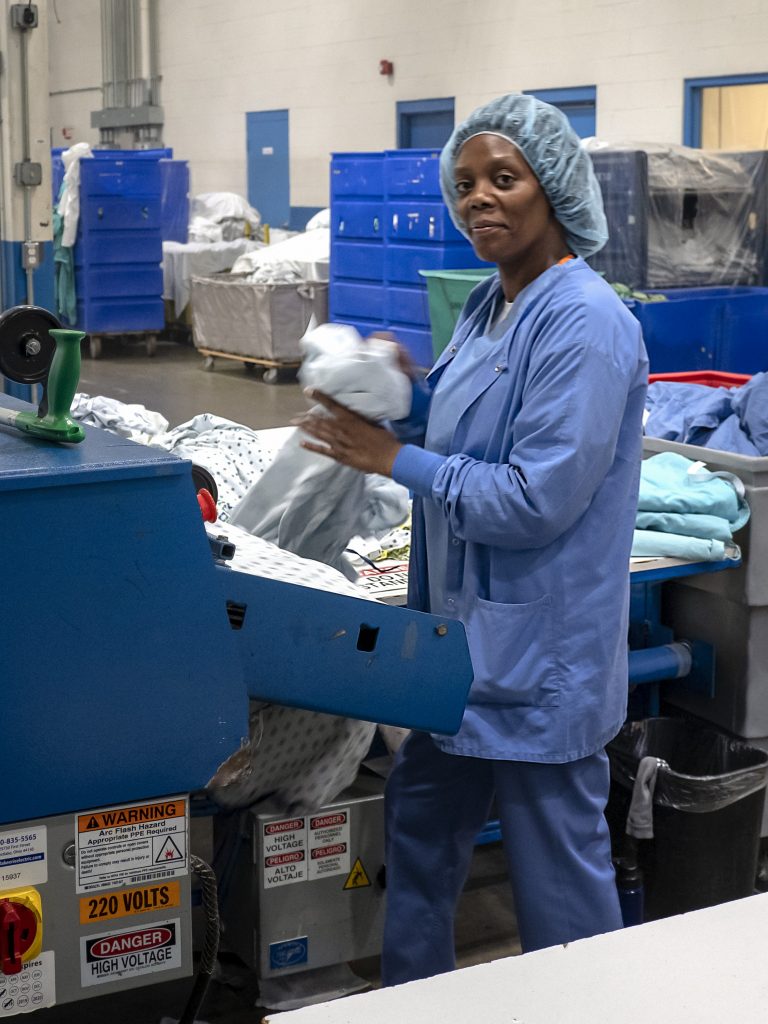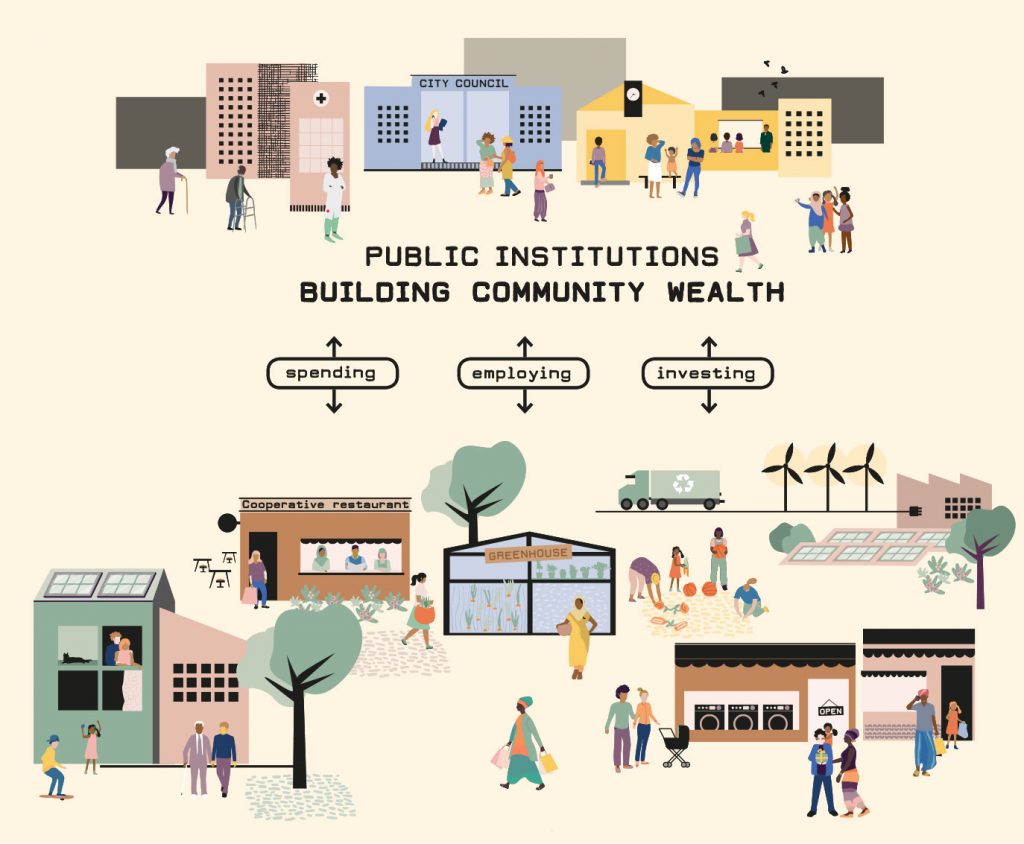This essay is part of the book Public Finance for the Future We Want, you can find the entire collection of essays .
Ten years after the Great Financial Crisis of 2008, little has changed in the underlying structure of the American financial system. It remains highly consolidated, risky, financialized and speculative. Rather than a financial system designed to extract wealth from local communities, we need one that supports efforts to build community wealth. To start, we need to think about our existing financial and economic resources differently. By leveraging the procurement, investing, employment and other capacities of large-scale ‘anchor institutions’ – place-based public or non-profit organizations – we can begin to build more resilient, equitable and sustainable local economies.
When the United States’ financial system collapsed in spectacular fashion in 2008-2009 following decades of deregulation, financialization, consolidation and speculation, it sent economic shock waves around the world. This could have heralded the end of capitalism as we knew it, but due to a massive public rescue plan that saved most of the giant Wall Street financial corporations and the ‘1 per cent’ while abandoning tens of millions of ordinary Americans to suffer foreclosure, bankruptcy and unemployment, this did not occur. Highly financialized corporate capitalism not only survived, it has become even more entrenched. Attempts at financial reform have largely failed: the ‘too-big-to-fail’ banks are now even bigger; the expansion of the financial sector (and reliance on it for growth) continues unabated; new scandals and frauds are uncovered with alarming regularity (Wells Fargo and Citigroup to name just two of the worst offenders); and a highly risky and unregulated shadow banking sector is growing.1
According to the conventional narrative, the US economy has now largely recovered from the crisis. But this belies great unevenness, instability and suffering in many local communities that are continuing to lose population as good jobs disappear. Small, local businesses (the engines of job creation in local communities) are vanishing in the face of behemoth corporations such as Walmart and Amazon. Unemployment, poverty and inequality remain shockingly high in disinvested communities. These trends started well before 2008 because they are, at least in part, linked to structural changes in the US financial sector. In short, finance in the neoliberal era is designed to extract wealth from local communities in order to fuel speculation in increasingly complex, opaque and global financial products (for the benefit of the few) rather than to efficiently allocate capital to individuals and local businesses. One of the clearest signs of this in the United States is the necessity of a law, the Community Reinvestment Act, requiring banks that take deposits in a certain area to reinvest at least some of this money (in the form of loans and investments) in that community.2
Community wealth building
The alternative to wealth extraction is ‘community wealth building’. The term, coined by my colleagues at The Democracy Collaborative in 2005, describes an asset-based approach to bottom-up, equitable, inclusive and sustainable economic development. Within the overarching framework of subsidiarity, there are eight basic principles of community wealth building:
- Labour before capital: We need an economy in which people matter
more than just maximizing profits. - Broad-based ownership: A thriving and equitable economy requires
ownership where control and economic advantages are spread broadly (e.g. cooperative, community, public or worker ownership). - Active democratic participation: To build community wealth, we need to rebuild the fabric of active community, with opportunities for real par- ticipation and collective decision making at all levels of the economy.
- Multipliers: Local purchases keep money in the community longer where it ‘multiplies’ because residents and businesses are more likely to spend locally. This translates into a more prosperous, stable and tighter-knit
community. - Localizing investment: There are vast pools of capital in the investment
portfolios of local anchors; in personal, institutional and public bank deposits; and in pension funds and retirement plans. If deployed locally
these assets could be a powerful vehicle to build community wealth (rather than fuel financial speculation). - Collaboration: Building community wealth is not just about more money locally, it is about the power (including political) that comes from build- ing lasting relationships of mutual support.
- Place: An intentional place-based strategy to make sure local assets work to build community wealth is needed to ensure that those who need it most in local communities are first in line for new opportunities.
- Systemic change: Community wealth is not about isolated, small pro- jects within the current political economic system. It is where the next system begins and is about taking the first steps towards truly trans- forming our economy so that it works for the many, not the few.
While not neglecting the urgent imperative to fundamentally restructure the existing, extractive financial sector, community wealth building envi- sions mobilizing other sources of capital and assets to catalyze and scale new democratic, equitable and sustainable businesses, organizations and approaches at various levels.

Anchor institutions
As mentioned above, one source of such capital and assets can be found in anchor institutions – large, public and not-for-profit institutions rooted in local communities that reject their for-profit counterparts’ strategy of extracting public subsidies or moving facilities where labour and other costs are the lowest in a race to the bottom on tax revenue, job quality, services and environmental standards. Anchor institutions can include hospitals and health facilities, schools and universities, cultural institutions (e.g. muse- ums), community foundations and other philanthropic organizations and local government (including municipally owned enterprises). In the United States, hospitals and health systems alone collectively spend more than $900 billion annually and hold investment portfolios of $400 billion.3 Adding in universities takes the spending total to roughly $1.5 trillion a year and investment portfolios to nearly $1 trillion.4 Moreover, these institutions are recipients of considerable public funding in the form of reimbursements for healthcare services (from programmes such as Medicare and Medicaid), tuition assistance, general operating support (especially for public institutions), research grants and more. For instance, in 2016 the Cleveland Clinic – a massive health system based in Cleveland, Ohio – received $1.81 billion in payments from Medicare and Medicaid alone, amounting to 35 per cent of its total revenue.5 Anchor institutions are often exempt from many local, state and federal taxes and are major land and other physical asset owners.6 In some US cities, non-profit organizations (with universities and hospitals being the most dominant) own more than half the land.7 This represents a large-scale public subsidy and creates a problem for many cash-strapped cities that rely on property taxes to fund basic operations and services.
Increasingly, and with assistance from groups like The Democracy Collaborative, the Coalition of Urban and Metropolitan Universities, the Anchor Institutions Task Force and many others, local stakeholders across the United States including community groups, economic development practitioners and municipal officials are coming to see anchor institutions as a potentially game-changing resource for advancing equitable, democratic and sustainable economic development at significant scale and building community wealth. Moreover, these anchor institution strategies and approaches are beginning to spread around the world. In Toronto, Canada, for instance, the Atkinson Foundation and others are looking to build upon existing small-scale experiments and take advantage of the massive economic power of local anchor institutions (with more than $10 billion in annual procurement and hundreds of thousands of jobs).8
For their part, many anchor institutions are beginning to engage with and embrace the ‘anchor mission’, that is a commitment to intentionally and comprehensively apply the institution’s assets in partnership with community to mutually benefit the long-term well-being of both. In the United Kingdom, for instance, the National Health Service with its £110-billion annual budget and 1.4 million employees has recently included anchor institution language in its strategic plan.9 For these institutions, the anchor mission can include filling supply chain gaps, reducing hiring costs and workforce turnover, creating more resilient supply chains and reducing costs associated with unnecessary and preventable hospitalizations. This commitment can be expressed in at least three areas: procurement, investment and workforce.10
Procurement
Many large anchor institutions purchase billions of dollars of goods, services and supplies each year, yet very little of this is spent locally. If even a small amount of an anchor institution’s purchasing is directed to local or democratically owned businesses, it can have considerable positive economic impacts in the surrounding community.
Procurement dollars spent at diverse, local vendors recirculate in the community at a greater rate than money spent with large, extractive corporations. This has a multiplier effect that can lead to more jobs, greater tax revenues, better public services and, ultimately, healthier, safer and more prosperous communities. Moreover, procurement dollars that are spent at local, democratized businesses such as worker cooperatives, employee-owned firms and social enterprises run by non-profits and community corporations, as is happening in Cleveland, provide additional benefits related to family wealth and asset building.
Box I
Evergreen Cooperatives network
The Evergreen Cooperatives In Cleveland, The Democracy Collabora- tive worked with partners in local government and the philanthropic community to help set up the Evergreen Cooperatives network of worker-owned companies. The network currently consists of three ecologically sustainable worker cooperatives with a total of 200 workers, and was consciously set up to meet the procurement needs of large anchor institutions in the local community ($3 billion annual spending on goods and services). The network currently includes a large-scale green laundry, a solar panel installation and energy retrofit cooperative, and one of the larger urban greenhouses in the United States.
This strategy is beginning to bear fruit, with the cooperatives winning contracts from the anchor institutions and workers– owners enjoying good paying jobs with benefits (including a home- ownership programme) and building their capital accounts. In May 2018, the laundry cooperative announced a massive expansion when it was awarded a contract to take over operations from the Cleveland Clinic. As a result, more than 100 workers at the new facility are on an expedited path to ownership.

Investment
Many anchor institutions have significant financial assets in the form of investments, much of which currently helps fuel the speculative activity of Wall Street. If a portion of these resources were reallocated to place-based investments it would shift billions of dollars towards addressing econom- ic and environmental disparities in local communities (with a continuing healthy rate of return). Ways in which anchor institutions can begin to use their investment assets to build community wealth include:
- shifting some of their sizeable deposits into local community banks and credit unions (especially community-development financial institutions) where they can be used to expand capital access to residents and local businesses
- providing capital to financial intermediaries that lend to borrowers
that are addressing local social, economic and environmental needs (e.g. worker cooperative development funds) - making direct investments in local businesses that provide community benefits and helping them convert to employee ownership
- investing in local public infrastructure, affordable housing, renewable energy systems and other projects with positive social, economic and environmental impacts.
Box II
Trinity Health
Trinity Health Headquartered in metro Detroit, Trinity Health operates in 22 states, employs 133,000 people and has revenues of $17.6 billion.11 Formed when several Catholic health systems merged, Trinity institutionalized the community investment programmes that some of these smaller systems had developed and adopted a socially responsible investment policy in the early 2000s. While Trinity’s Community Investing Program currently only consists of roughly 1 per cent of its operating investment portfolio, this still amounts to tens of millions of dollars invested in community development (e.g. affordable housing, business development, healthy food access, schools and community facilities) through local community- development financial institutions. Loans are usually made for three-year terms, with five-year terms for larger institutions, and generate an average 2 per cent rate of return.
In 2016, Trinity launched the Transforming Communities Initiative, a set of six community multi-sector partnerships that will receive a combination of grants, loans and technical assistance. Trinity focuses its investments on underserved communities generally, and the needs of women and children specifically. It believes that ‘the business case is the health case (…). Community investment can no longer be seen as “nice to have” and an add on, but as necessary to improve the health of the communities that hospitals serve.’12
Workforce
Anchor institutions are also major employers in many local communities. For instance, in Baltimore, Maryland, the top four largest private-sector employers (including non-profits) are anchor institutions: Johns Hopkins University (27,095 local employees); the University of Maryl and Medical Center (22,533 local employees); John Hopkins Health System (22,090 local employees); and MedStar Health (10,400 local employees).13 Through local and inclusive hiring, along with conscious-training and workforce- development efforts, anchor institutions can create career pathways for low-income, minority and hard-to-employ populations. The good jobs with benefits and career pathways offered by many anchor institutions can be transformative in their communities, especially where unemployment is high and skills and educational attainment are low. It creates a multiplier effect as economically secure workers buy homes (and upgrade existing ones), spend money locally, get appropriate medical care and pay more in taxes (which improves schools and other services). And for anchor institutions, building robust and inclusive local-hiring pipelines is a long- term investment in a workforce that is more productive and invested in institutional success, in addition to the benefits of a neighbouring community that is healthier, safer and more economically secure.
One example is the West Philadelphia Skills Initiative (a workforce intermediary), which partners with anchor institutions to train local residents for specific full-time jobs that are connected to a career ladder at local anchor institutions. The programme focuses on a 4-km2 geographic area with around 240,000 people and 75,000 jobs. The application and screening process is highly competitive and selected participants are paid during training to enable engagement. The training process is specifically tailored to the skillset required to fill vacant positions at a participating anchor institution (such as certified medical assistants, in-patient clerks, lab technicians, security officers and information technology support). While there is no requirement that the anchor institutions hire graduates, the programme has a 95 per cent placement rate and a 92 per cent retention rate.14
Box III
The Preston Model
In the United Kingdom, leaders on the Preston City Council were partly inspired by the Evergreen Cooperatives model described above and are working with the Centre for Local Economic Strategies (CLES) to respond to the failures of the extractive financial system.15 The city had been pinning its economic revitalization hopes on a £700-million shopping centre with large national chain stores; but after the devastating financial crisis, credit and demand began to dry up, the companies pulled out and the development plan collapsed.
So far, the ‘Preston Model’ has been remarkably successful. In 2013, seven local anchor institutions (including the Preston City Council, the University of Central Lancashire, Preston’s College and Cardi- nal Newman College) collaborated to spend £38 million in Preston and £292 million in the surrounding county (Lancashire). By 2017 this was up to £111 million and £486 million respectively, with new local contracts covering everything from school lunches to large- scale construction projects.16
As part of the Preston Model, the Council has also helped estab- lish the Preston Cooperative Development Network, which seeks to develop worker- and consumer-owned businesses in the city.17 In early 2019, the network helped launch a worker-owned restaurant with a social-benefit mission located in a publicly owned property. The Council was also one of the first in the nation to embrace a living-wage standard, adopting it for council employees and encour- aging other enterprises in the city to do the same.18
Conclusion
More than ever, our financial system remains predicated on an extractive and speculative model that prioritizes the profits of a few over investments that can benefit the many. Another financial crisis is a certainty; only the questions of timing and severity are up for serious debate. And when the crisis comes, it will be families and businesses at the local level that will inevitably be hardest hit. Communities should be actively preparing for this eventuality by leveraging their existing resources to build resilient, equitable and sustainable local economies. Such resources include the economic and financial power of local anchor institutions that exist, in one form or another, in every community around the world. These anchor institutions are increasingly understanding that, as major economic players and conduits of significant public funds, they have both the capacity and moral obligation to meaningfully improve the lives and livelihoods of their neighbours, employees, students and patients. Along with interventions at various other levels, this can begin to form the basis for a structurally different financial system.
About the author
Thomas M. Hanna is Research Director at The Democracy Collaborative, a research and develop- ment lab for a more democratic economy based in Washington, DC. His areas of expertise include democratic models of ownership and governance, particularly public and cooperative ownership. His recent publications include Our Common Wealth: The Return of Public Ownership in the United States (Manchester University Press, 2018), The Crisis Next Time: Planning for Public Ownership as an Alternative to Corporate Bank Bailouts (Next System Project, 2018) and, with Jarrid Green, Community Control of Land and Housing: Exploring Strategies for Combating Displacement, Expanding Ownership, and Building Community Wealth (Democracy Collaborative, 2018).

Notes
1 Parts of this introduction are excerpted from a new paper by the author. For full details and statistics on some of these trends, see: Hanna, T. M, (2018) The Crisis Next Time: Planning for public ownership as an alternative to corporate bank bailouts. Washington, DC: The Democracy Collaborative.
2 The law, while incredibly valuable, is: 1) insufficient to meet the capital needs of local communi- ties; 2) based on physical banking locations and in need of reform to keep up with increasing structural changes in the financial sector (including the rapid closure of physical branches in many communities); and 3) relatively weak when it comes to penalties for non-compliance. For more on this, see: Case-Ruchala, D. (forthcoming) The Next System of Community Investment: Community reinvestment act reform in the 21st century. Washington, DC: The Democracy Collaborative.
3 Jones Sanborn, B. (2018) ‘AHA Report: Hospitals spend almost $3 trillion, support more than 16 million jobs’, Healthcare Finance, 7 June. Available at: https://www.healthcarefinancenews.com/ news/aha-report-hospitals-spend-almost-3-trillion-support-more-16-million-jobs (retrieved 27 August 2018).
4 ‘In academic year 2014-15, postsecondary institutions in the United States spent $536 billion (in current dollars).’ See: National Center for Education Statistics (2018) ‘Fast Facts: Expenditures’. Washington, DC. Available at: https://nces.ed.gov/fastfacts/display.asp?id=75 (retrieved 27 August 2018). ‘At the end of fiscal year 2015, the market value of the endowment funds of colleges and universities was $547 billion.’ See: National Center for Education Statistics (2018) ‘Fast Facts: Endowments’. Washington, DC. Available at: https://nces.ed.gov/fastfacts/display.asp?id=73 (retrieved 27 August 2018).
5 It also received $110 million in federal support for research as well as grants, contracts, dona- tions, and services from a variety of other public entities. See: Department of the Treasury, Internal Revenue Service (2016) ‘Form 990—Cleveland Clinic’. Available at: https:// my.clevelandclinic.org/scassets/files/org/about/financial-statements/2016-form-990. ashx?la=en (retrieved 2 September 2018). Also see: Cleveland Clinic (2016) ‘Financial and Statistical Highlights—Annual Report 2016’. Available at: https://my.clevelandclinic.org/-/ scassets/files/org/about/who-we-are/17-ccc-464-annual-report-financials-v3.ashx?la=en&_ ga=2.137492153.841868843.1530189269-1827665723.1530189269 (retrieved 2 September 2018).
6 For an in-depth discussion of anchor institutions and their relationship to land and housing in local communities, see: Green, J. and Hanna, T. M. (2018) Community Control of Land and Housing: Exploring strategies for combating displacement, expanding ownership, and building community wealth. Washington, DC: The Democracy Collaborative.
7 Thelin, J. R. and Trollinger, R. W. (2014) Philanthropy and American Higher Education. New York: Palgrave McMillian, p. 140.
8 Dragicevic, N. (2015) ‘The Prosperous Province: Strategies for building community wealth.’ Toronto: Mowat Center and the Atkinson Foundation. Available at: http://www.anchorinstitutions.ca/ (retrieved 27 February 2019).
9 National Health Service (January 2019) ‘NHS Long Term Plan’. Available at: https://www.longtermplan.nhs.uk/wp-content/uploads/2019/01/nhs-long-term-plan.pdf (re- trieved 27 February 2019).
10 Information in the following sections is drawn from The Democracy Collaborative’s Hospitals Aligned for Healthy Communities Toolkits (2016). For more information, as well as other case studies from across the United States, please see: http://hospitaltoolkits.org/.
11 ‘Facts and Figures/Financial Strength’, Trinity Health, Livonia. Available at: http://www.trinity-health.org/financial-strength (retrieved 2 September 2018).
12 Zuckerman, D. and Parker, K. (2016) ‘Trinity Health: Community Investing Program’. Hospitals Aligned for Healthy Communities Toolkits. Washington, DC. Available at: http://hospitaltoolkits. org/investment/case-studies/trinity-health/ (retrieved 2 September 2018).
13 Sieron, M. (2017) ‘The 5 Largest Private-Sector Employer is Greater Baltimore’, Baltimore Business Journal, 25 August. Available at: https://www.bizjournals.com/baltimore/ news/2017/08/25/the-5-largest-private-sector-employers-in-greater.html
14 Zuckerman, D. and Parker, K. (2016) ‘West Philadelphia Skills Initiative’. Hospitals Aligned for Healthy Communities Toolkits. Washington, D.C. Available at: http://hospitaltoolkits.org/workforce/case-studies/west-philadelphia-skills-initiative/ (retrieved 2 September 2018).
15 Todd, M. (2017) ‘Local Wealth Building: Harnessing the Potential of Anchor Institutions in Preston’, CLES, 19 October. Available at : https://cles.org.uk/blog/local-wealth-building-harnessing-the-potential-of-anchor-institutions-in-preston/ (retrieved 2 September 2018).
16 For more, see: Hanna, T. M. et al., 2018 ‘The ‘Preston Model’ and the Modern Politics of Municipal Socialism’, openDemocracy, 12 June. Available at: https://www.opendemocracy.net/neweconomics/preston-model-modern-politics-municipal-socialism/ (retrieved 29 June 2018).
17 Manley, J. (2018) ‘Preston used ‘Corbynomics’ to change its fortune. Now other cities are doing the same’, CityMetric, 7 November. Available at: https://www.citymetric.com/business/preston-used-corbynomics-change-its-fortune-now-other-cities-are-doing-same-4332 (retrieved 27 February 2019).
18 Brown, M. (2017) ‘Celebrate the Living Wage’. Preston Guild City. Available at:
https://www.prestonguildcity.co.uk/blogs/preston-guild-blog/2017/11/celebrate-living-wage//
(retrieved 27 February 2018).
